
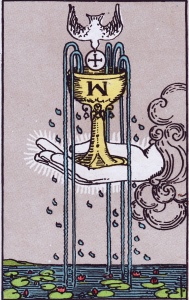
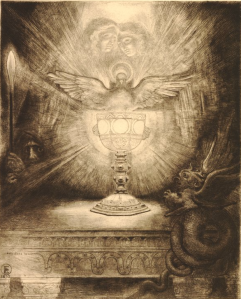
The Waite-Smith Ace of Cups image is not unique. A winged figure surmounts a fountain from which streams water in the Visconti-Sforza card. In the Marseille deck two of the aces (Wands and Swords) have a hand emerging from a cloud—a standard medieval device to indicate creation, miracles and gifts from a Divine source. We also find similarities in the pictures above. The first one is from Wilhelm Hauschild’s Temple of the Holy Grail (1878) and the third one is Santo Griaal by Rogelio Egusquiza (acquired by the British Museum in 1901). By the way, if you are Pagan, like me, I encourage you to look at the Christian references as psychological metaphors. Read Part 1 here.
Hand & Cloud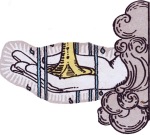
To display His divine nature, the hand of God is often depicted emerging from a cloud which hides his body, veiling us from his power as no person could see Him and live. As it is the right hand, it is actively giving the viewer one of the four sacred treasures found in the myths of many cultures. In the Talmud the Cup of Blessing is held on five fingers of the right hand representing the five leaves that protect a rose from its thorns. This image signifies a divine gift in the form of a supernatural vision (the cloud) that is often the starting point for a spiritual quest.
Dove & Host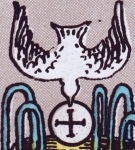
Waite has a lot to say about the dove, describing it as the invocation and descent of the Comforter or Holy Spirit to renew the virtue of the Grail and to consecrate the elements.
“In England during the Middle Ages . . . the Eucharist was reserved in a Columbarium, or Dove-House, being a vessel shaped like a dove. It recalls some archaic pictures of a Cup over which a dove broods and the descent of a dove on the Graal.” …
“There is the flight of the mystical dove from the casement to inmost Shrine, as if the bird went to renew the virtues of the Holy Graal.” …
“The Dove descends from Heaven carrying the Arch Natural Host to renew the virtues of the Stone [the form the Grail takes in some of the stories].” …
“O central point and sacred meeting-place of all the sacraments, there falls the Bread, broken within the Wine-Cup, and from both issues one living Spirit of Life Divine.” …
“On Good Friday, by the descent of a dove from heaven, carrying a sacred Host . . . the crown of all earthly riches were renewed.”
The Holy Spirit represents the life-giving spirit of air, and it was present at the baptism by water of Jesus, the awakening into a new life:
“As soon as Jesus was baptized, he went up out of the water. At that moment heaven was opened, and he saw the Spirit of God descending like a dove and lighting on him. And a voice from heaven said, “This is my Son, whom I love; with him I am well pleased.” Mark 1:10-11.
Additionally, the Dove maintains its pagan association with Goddess Venus/Aphrodite and with Love (Waite includes the ancient pagan mysteries in the Secret Tradition). The Dove blesses with supernatural gifts, like the gift of tongues (pictured as Yods, see below), and so it can be associated with the ancient “language of the birds” or gift of divination and with miracles. Waite favors the idea of Grace: “it is grace which fills the heart; it is the Holy Spirit of God which makes holy the spirit of man.” Grace, equated with the Hebrew word Chesed, is a blessing that gives guidance and protects us from the dangers of earthly power and adversity.
So, the Dove can be seen as the descent of Spirit into flesh, of the supernatural into the natural, a theme repeated by the cross on the Host composed of the vertical axis of spirit and the horizontal of matter. (The cross, which represents Christ’s suffering and sacrifice on the cross, becomes a blessing.)
I should note that Waite was known to have a prodigious and exacting memory. He was extremely precise in his use of language, so when an odd phrase appears it is usually a sign that he is quoting a source to further elucidate his meaning. The internet has made it possible to find a good number of these allusions.
For instance, for Waite the Host is the “panis quotidianus that has been changed into the panis vivus et vitalis“: that is the everyday bread is transformed into a living and vital bread. This quote from Waite refers to a popular hymn by Thomas Aquinas (circa 1264) called the Lauda Sion Salvatorem. It speaks of the Eucharist and presents the transformation of bread and wine ending with a familiar maxim “as above, so below”:
Here beneath these signs are hidden
Priceless things, to sense forbidden,
Signs, not things, are all we see. . . .Living bread, thy life supply:
Strengthen us, or else we die,
Fill us with celestial grace. . . .Thou, who feedest us below:
Source of all we have or know:
Grant that with Thy Saints above,
Sitting at the feast of love,
We may see Thee face to face.
Spiritual nourishment, the Host, is sent by the Holy Ghost; in many of the Grail stories it is found to heal all wounds.

Cup, Grail and Fountain of Living Waters
This is the signature image of this card and is filled with meaning on so many levels. We will touch on only a few. As container, it is a major symbol of the receptive feminine and, in Christianity, the womb of the Virgin Mary, the seat of creation and manifestation of Love, esoterically seen as “the Bride”. It is a vessel in which things are “cooked,” making raw materials capable of providing rich nourishment and even, in alchemy, changing lead into gold. It is the cup of transformation containing the waters of life in which water is changed into wine and then into blood. It is the cauldron of Dagda in Celtic myth from which no company ever left unsatisfied.
“The message of the Secret Tradition in the Christian Graal mystery is this: The Cup corresponds to spiritual life. It receives the graces from above and communicates them to that which is below. The equivalent happens in the supernatural Eucharist, the world of unmanifest adeptship, attained by sanctity [Grace].”
Both cup and water represent the soul.
The Practicus Ritual in Waite’s Fellowship of the Rosy Cross initiates one through an encounter with the Living Waters. First we are informed that Water symbolizes the emotions, desires, and psychic nature of earthly man. But this is not the Water one is to encounter in the ritual, “The Waters that are below desire after the Waters that are above. . . . May the peace of their Union be upon us; be we dissolved therein.”
“The Spirit of God moved upon the face of the Waters, and the Spirit of the Most High God shall move upon the Waters of the Soul. . . . The stilled waters of the soul receive the Spirit of God moving upon the face of its waters. . . . Open thy heart, O Brother of the Rosy Cross, and receive the Water of Life.”
“Fountain of fountains, and of all fountains. Chalice of saving rain. Grace on the soul descending, as rain on the dry grass. Life-giving Rain of Doctrine. Mystical Fruit of the Doctrine. Dew of Divine Speech, falling in stillness on the heart, filling the soul with Knowledge. Enter into the heart and purify; come into the soul and consecrate.”
The image is one of both the Baptismal font and the Eucharist. “A Eucharistic allegory concerns [the dissolution] of the body by Divine Substance communicated to the soul, putting an end to the enchantments and sorceries of the five senses” and to the suffering on the cross (mentioned earlier).
This leads us directly to the five streams coming out of the cup.
 Five Streams
Five Streams
Why five streams of water and not the four that Waite specifies in Pictorial Key to the Tarot? Furthermore, Bible readers all know that there are four streams that come out of Eden. This could be an error either on the part of Waite or Pamela Colman Smith. Or, it could veil a secret: These five streams might, after all, represent the five senses (see the quote immediately above), or the five ways of salvation and five gates of grace (from Masonic ritual), or the five wounds of Christ, the five points of the Pentagram, the five petals of the rose that rest on five leaves (the fingers), or the four elements plus aether—the quintessence. In terms of the symbolism, five yields far more relevance according to Waite himself:
“In the Longer Prose Perceval we have seen that there is an account of five changes in the Graal which took place at the altar, being five transfigurations, the last of which assumed the seeming of a chalice, but at the same time, instead of a chalice, was some undeclared mystery: so the general as well as the particular elements of the legend in its highest form offer a mystery the nature of which is recognised by the mystic through certain signs which it carries on its person; yet it is declared in part only and what remains, which is the greater part, is not more than suggested. It is that, I believe, which was seen by the maimed King when he looked into the Sacred Cup and beheld the secret of all things, the beginning even and the end. In this sense the five changes of the Graal are analogous to the five natures of man, as these in their turn correspond to the four aspects of the Cosmos and that which rules all things within and from without the Cosmos.”
I believe that despite their blue color, the five streams best represent blood, for as Marie-Louise von Franz tells us, “Grace was depicted as a fountain of Blood from the five holy wounds of Christ,” The Psychological Meaning of Redemption Motifs in Fairytales.
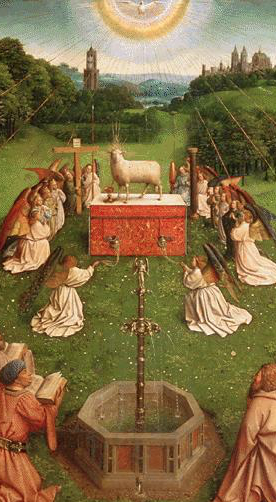 But it is in Evelyn Underhill, Anglo-Catholic author of a well-known book on mysticism, who perhaps reveals the deepest mystery. Underhill was a student or acolyte of Waite, having joined his branch of the Golden Dawn in 1904 and achieving at least four initiations. She wrote for Waite’s Horlick’s Magazine and published a novel in 1909 featuring the effects of the Holy Grail on a woman who came into its possession. In an article titled “The Fountain of Life” in the Burlington Magazine (1910) Underhill examined the fountains of water and of blood depicted on several religious works of art including the famous Ghent Altarpiece (right). She notes that baptism and penance which ‘renews the grace of baptism,’ are still spoken of by Catholic theologians as ‘effusions of the Precious Blood,’ i.e., of grace. She went on to describe:
But it is in Evelyn Underhill, Anglo-Catholic author of a well-known book on mysticism, who perhaps reveals the deepest mystery. Underhill was a student or acolyte of Waite, having joined his branch of the Golden Dawn in 1904 and achieving at least four initiations. She wrote for Waite’s Horlick’s Magazine and published a novel in 1909 featuring the effects of the Holy Grail on a woman who came into its possession. In an article titled “The Fountain of Life” in the Burlington Magazine (1910) Underhill examined the fountains of water and of blood depicted on several religious works of art including the famous Ghent Altarpiece (right). She notes that baptism and penance which ‘renews the grace of baptism,’ are still spoken of by Catholic theologians as ‘effusions of the Precious Blood,’ i.e., of grace. She went on to describe:
“, , , a fountain which is filled by the Blood flowing from the Five Wounds. The Soul, or ‘Bride,’ holds out her heart, and the blood from the wounded side of Christ falls upon it, causing flowers to spring up from the place which has been touched by the vivifying stream. The Precious Blood then . . . stands not merely for an emblem of the Passion, Redemption, or the Eucharist, though it includes all these manifestations of Grace, but for the medium of communication of the Divine Life . . . since for ancient and mediaeval thought the spirit of life resided in the blood.”
Given that the Aces are also seen by Waite as the four Celtic treasures, I’d be remiss in not presenting this option from Celtic Myth and Religion by Sharon Paice MacLeod:
“In Cormac’s Adventures in the Land of Promise, Cormac has a vision of the sacred center of the Otherworld where he saw a shining fountain with five streams flowing out of it. He is told that it is the Fountain of Knowledge [others call it the Well of Wisdom], and the five streams are the five senses through which knowledge is obtained.”
Drops of Dew or Yods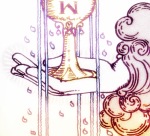
These drops, in the shape of the Hebrew letter Yod are found on many of the Tarot cards, generally signifying divine Grace. Shaped like a flame a Yod is the divine spark of creation that is the foundation of all the other letters and is the first letter in the Tetragrammaton or four-letter name of God. There are 26 yods and Eoin Keith Boyle notes in the comments that this is the sum of the 4-lettered name of God, the Tetragrammaton, in Kabbalistic gematria. They are also the shape of the tongues of fire at Pentecost:
“They saw tongues like flames of a fire that separated and came to rest on each of them. And they were all filled with the Holy Spirit and began to speak in other tongues as the Spirit enabled them.” Acts 2:3-4.
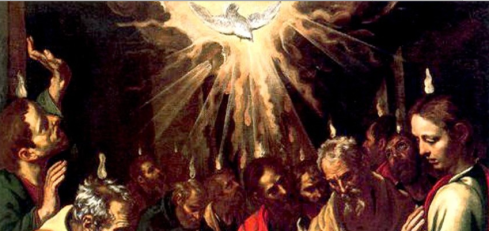
The alchemist Thomas Vaughn, in a compendium by Waite, calls it the divine spark or star-fire that is sympathetically attracted to its origin in God. It is spirit fructifying the soul.
These drops can also be seen as alchemical dew. Thomas Vaughn again explains that divine dew penetrates and transforms all that is physical. Waite claims that for the Rosicrucians “dew is light, coagulated and rendered corporeal. . . . When digested in its own vessel it is the true menstruum of the Red Dragon, i.e., of gold, the true matter of the Philosophers.”
Pool of Water
[In the beginning] “the Spirit of God moved over the face of the waters.” Genesis 1:2.
It is the soul that desires union with the spirit, “The Waters that are below desire after the Waters that are above.”
This is also the generative water of renewal and rebirth. It also represents the emotions which here have become serene and calm, being fed by the waters of the Holy Spirit. In the parlance of Carl Jung it is the rich and fertile pool of the unconscious psyche—the soul. And Evelyn Underhill already explained that the blood from Christ’s wounds causes flowers to spring up—in this case water-lilies that grow only in sweet waters, reaching up from the mud toward the light. Regarding sweet waters, in Waite’s book of aphorisms, Steps to the Crown, we find: “The Cup of bitterness ceases to exist for him who has drunk from the chalice of immortality”.
W or M ?
Finally we come to the major controversy associated with this card—What is the significance of the letter on the cup? The fact is that we will never know, but we do have some very likely possibilities, and knowing Waite, all of them may have been what was intended, for Waite saw all symbols as multi-valenced.
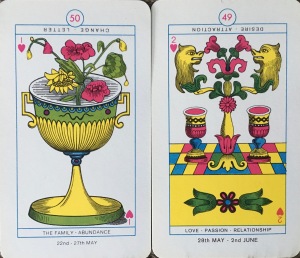 MacGregor Mathers, in his 1888 book Tarot: A Short Treatise on Reading the Cards claims that an inverted M on the front of the Spanish Ace of Cups represented the waters of creation in Genesis and all that remains of an Egyptian motif of twin serpents (as per this 19th century deck reproduced in the Cagliostro Tarot by Modiano of Italy). The Golden Dawn paper on the Tarot, “Book T,” says, “The great Letter of the Supernal Mother is traced in the spray of the Fountain.”
MacGregor Mathers, in his 1888 book Tarot: A Short Treatise on Reading the Cards claims that an inverted M on the front of the Spanish Ace of Cups represented the waters of creation in Genesis and all that remains of an Egyptian motif of twin serpents (as per this 19th century deck reproduced in the Cagliostro Tarot by Modiano of Italy). The Golden Dawn paper on the Tarot, “Book T,” says, “The great Letter of the Supernal Mother is traced in the spray of the Fountain.”
First it is note-worthy that the letter is shaped exactly like Pamela Colman Smith’s Ms and not like her Ws
and not like her Ws .
.
The main contenders for W are:
Waite (see the monogram on the Ten of Pentacles)
Water (“the implicit is that the Sign of the Cups naturally refers to water” PKT.)
Womb
Wisdom (more specifically, the Celtic Well of Wisdom)
Woman
The main contenders for M are:
Mystery (“For this is the chalice of my blood, of the new and eternal testament: the Mystery of Faith”).
Mem (or Maim, Hebrew for “water”)
Mary (or Mara, which also means “bitter sea”)
Mother (Matter. As Supernal Mother she is associated with Binah on the Tree of Life and the 2nd letter of the Tetragrammaton, He.)
Mercury (an alchemical maxim: “What wise men seek in Mercury is found”)
I believe that the letter is M and that it stands for Mystery, as viewed from above by the Holy Spirit. It is probably the word Waite uses most in his books where it is usually capitalized. To support this I have found almost this identical summary statement in several of Waite’s books:
“[In conclusion] the maxim which might and would be inscribed over the one Temple of the truly Catholic Religion when the faiths of this western world have been united in the higher consciousness–that is assuredly ‘Mysterium Fidei’–the mystery which endures for ever and for ever passes into experience.” HCHG, p. 469
We might also view the letters like this:
Waite – Mystery
Water – Mem
Womb – Mary/Mother
Wisdom – Mercury
An Act of Imagination
I suggest one final way of getting at the deeper meaning of this card.
Imagine for a moment that you are the Chalice and, perhaps, the liquid in the chalice. Picture yourself reaching up for the host held in the beak of the dove. You might see yourself as a baby bird stretching up to be fed by a parent. Can you experience the yearning? Or you may be a font of water that wells up from a deep source. Feel the draw from above and your yearning toward the source of that draw. Become aware of the wounds gathered through your earthly experience. The water (or blood) within you could begin to spill over, rising up and falling out in a continuous stream. Can you let yourself go, surrender to the movement, and then to gravity so that you fall into the pool beneath? What happens when you spill into that pond? Where do you go? How do you reflect back what is above?
One final characteristic of Cups, which Waite mentions over and over again through his discussion of the suit, is fantasy—the ability to imagine super-sensible things and have experiences of what he calls the Arch-Natural world. While there are dangers in doing so (the Seven of Cups), it is in through mystical experience, first accessed through the door of the imagination, that we are ultimately able to commune with Spirit. I hope to speak more about this in a third post on a Jungian interpretation of this image.

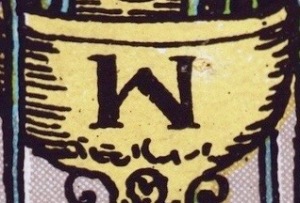
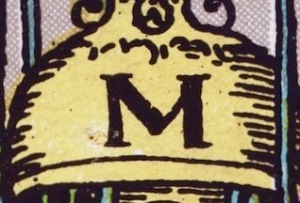
 Mary K. Greer has made tarot her life work. Check here for reports of goings-on in the world of tarot and cartomancy, articles on the history and practice of tarot, and materials on other cartomancy decks. Sorry, I no longer write reviews. Contact me
Mary K. Greer has made tarot her life work. Check here for reports of goings-on in the world of tarot and cartomancy, articles on the history and practice of tarot, and materials on other cartomancy decks. Sorry, I no longer write reviews. Contact me
24 comments
Comments feed for this article
December 13, 2017 at 11:33 am
Naha Armády
This is such an excellent and informative exploration of this card and symbolism, thank you for sharing your wisdom!!
Blessings, Naha
22 Teachings
December 13, 2017 at 11:36 am
Waite’s Eucharistic Ace of Cups | Mary K. Greer's Tarot Blog
Be sure to read Part 1 on Waite’s Eucharistic Ace of Cups.
December 13, 2017 at 11:54 am
Robert Cohen
Hi Mary This is such great work that you are putting out. So grateful for it. As well as the previous blog sent out a few days ago. Would love to talk to you about it.
Several years ago I was introduced to the Ace of cups through a reading for a client. For 2-3 years following my readings were often much about that Ace – as the spiritual heart (thymus gland) and how crossing the rainbow bridge (diaghragm) to the heart chakre we move our love from the physical heart (3 swords) to the central heart and all that that entails. I probably have enough to write a manuscript or short text on the subject.
So overwhelmed to receive all this from you. Thank you so much Are you still going to Omega and coming to NY? Would like to talk to you about several things. Cheers Bobby
December 13, 2017 at 12:27 pm
mkg
Bobby,
It’s so good to hear from you. I edited out some person information. Yes – I’m teaching at the Omega Institute from Aug 3-5, 2018 (our Tarot Conference) and Aug. 6 to 10 with Rachel Pollack. I’m also one of the featured speakers at Readers Studio in NY April 27-29. We’ll talk.
Mary
December 13, 2017 at 12:30 pm
mkg
Naha,
I’m glad you liked the post and thank you for telling me.
Mary
December 13, 2017 at 12:53 pm
Eoin Keith Boyle
26 is one enumeration of the Tetragrammaton, as well as the sum of integers 1-10
December 13, 2017 at 1:13 pm
mkg
Eoin,
Thank you for the gematric sum of the Tetragrammaton – wonderful. I added it to the post. However 55 is the sum of the integers 1-10 and 28 is the sum of 1-7. I did find that Matthew 26:26 is at the last supper where Jesus says, “This is my body.”
December 13, 2017 at 2:24 pm
mkg
I found a more extended list of Ws and Ms in one of my old posts:
W
Waite
Water
Wine
Will (representing the Sword in the Cup)
Wafer
Work (as in Great Work)
Word (as in “the Word made flesh,” Christ as the True Word and the Lost Word of Freemasonry)
Woman
West (direction of Water)
World (spirit into matter)
M – From above, the Divine perspective, it could be:
Mem
Mary
Mother/Matrona
Mystery/Mysticism
Micro/Macrocosm
Matter
Magus/Magician
Mass
December 13, 2017 at 6:22 pm
David Vine
Mary, don’t forget… “M” stands for “Maria” (Mary), yes, stress accented on the “i”… but the same Latin word, with the accent on the first “a” is “maria” means “seas,” “oceans,” “waters.” Waite was an excellent Latinist. David V
December 14, 2017 at 8:57 am
mkg
David,
Yes, Maria, too. I didn’t put in all the related words like Matrona, Mara, Mater, but tried to stick closest to the words Waite most used in his many books. Of course the main word for the divine feminine that he used was Shekinah but it begins with the wrong letter.
December 14, 2017 at 12:39 pm
sweetwood19
Understood. Still, additional rambling thoughts…The letter M is derived, through Phoenician, from the Egyptian hieroglyph for water which was just a wavy line, a series of multiple crests and troughs, i.e. a continuum of M’s and W’s. [W]ater is life. The cup upright. Turn over and poured out, i.e. the spells death… in Latin [M]ors. The Hebrew equivalent to the letter M, Mem, is the 13th letter of the Hebrew alphabet. And the numerical value of Mem, is 40. When God destroyed the earth by water, killing nearly all living creatures, he caused it to rain for forty days/nights. Fun!
December 14, 2017 at 1:26 pm
mkg
sweetwood,
Interesting. I never thought that the M on the upside-down cup could stand for Mors (Muerte, etc.). Of course dissolution in water is a kind of death, taking away all boundaries and into formlessness. Of course this speaks to the fear of the unconscious that Jung and Marie-Louise von Franz were very familiar with.
Regarding the wavy line for M, Mathers (I believe) noted that old Spanish decks contained a wavy line on their Ace of Cups, which may have been the idea behind putting the letter on the cup.
December 29, 2017 at 9:50 am
John Sorbo
Hi Mary. Just finished reading part 2 of your article on the Ace of Cups. Thanks so much for writing this continued scholarly interpretation of one of my favorite cards in the RWS deck! You have given all of us, who love the Tarot, much to think about in regard to the many layers of meanings attributed to this card. I recently purchased Waite’s book, The Hidden Church of the Holy Grail, and find your articles quite helpful in deciphering Waite’s text. Looking forward to your 3rd installment on this subject from a Jungian point of view. Happy New Year! In Peace, Love and Light, John
January 4, 2018 at 10:29 am
mkg
John,
Yes, it is the layers that make Tarot so endlessly fascinating. While I emphasized Waite, it’s perfectly valid to look at this or any other card from a multitude of other perspectives—which is why Tarot has been depicted from so many different cultural points of view. IMHO, Waite was brilliant but oddly repressed. His writing always feels like he is holding the good parts back, but I don’t think he meant to do so. I hope to get back to the Jungian perspective soon.
Mary
April 23, 2018 at 11:28 am
Ashley
What an amazing breakdown! So happy to have come across this site, so in depth and full of great research!
April 23, 2018 at 11:46 am
mkg
Thank you, Ashley. I’m happy to hear it has been helpful to you.
Mary
October 1, 2018 at 5:52 pm
Linkage: Lunar relationships, Yule goats, and crystal bongs | Spiral Nature Magazine
[…] K. Greer on the symbolism in tarot’s Ace of Cups, and more specifically, Arthur Edward Waite’s eucharistic Ace of […]
March 14, 2019 at 10:22 am
Ace of Cups | Weekly Card Part 4: Symbolism – Karma Star Tarot
[…] In the description of the Tarot cards on Monday I explained why I thought that the letter on the Cup was actually an inverted M rather than a W. However, I wanted to add in here that upon further reserch on the matter (as many have hmmed and hawwed over this, I wante dto find out if anyone had any concrete backing to their opinion), Mary K. Greer writes the potential meanings for each letter as contenders on her blog. […]
August 13, 2019 at 10:11 am
Donna Royston
I think it is more likely that the W is the Phoenician letter W (shin), which developed into the Hebrew letter Shin. In Paleo-Hebrew it is written exactly as a W, then develops into the later, more rounded Hebrew letter. The letter Shin stands for Shaddai, a name for God. A Jewish priest forms the letter Shin with his hands when he recites a blessing.
So, given the surrounding imagery of a cup (Holy Grail), dove, wafer, and the hand of God, I think this is the best interpretation.
August 13, 2019 at 5:05 pm
Mary K. Greer
Donna,
Thanks for adding to the possibilities for the W. If you ever find a reference to this in Waite’s writings then it would become more probable. You would think if Waite and Smith had meant it to be the Hebrew letter Shin they would have made it look like a Shin – as found on the Fool’s tunic.
Mary
December 8, 2019 at 7:35 am
Sandra
Sooo interesting and very helpful for a greater understanding of the tarot cards.
Many thanks for the concern and dedication you show by sharing this amount of qualitative and informative researches: it is hugely appreciated.
Much love and many blessings!💖
Sandra.
March 31, 2020 at 2:00 pm
Tarot Treks: The Ace of Cups - Veil and Vow Tarot
[…] streams of water coming out of the chalice. What’s up with that? If you want to get deep into the ace of cups symbolism, or the symbolism of any of the cards, check out the books and blog posts from Mark K. Greer. For […]
February 4, 2022 at 6:25 am
Jake
As a pagan struggling with christian imagery, I would love to hear more commentary on how to approach these images and meanings from a pagan persepctive. Thank you !
August 31, 2022 at 7:37 am
What is the Symbolism Behind the Ace of Cups? – My WordPress
[…] streams of water flow out of the cup. There is some debate over what exactly each stream of water represents. The Ace of Cups is overall closely associated […]